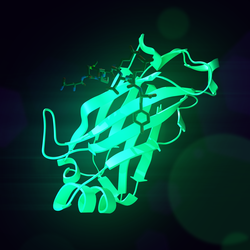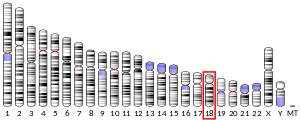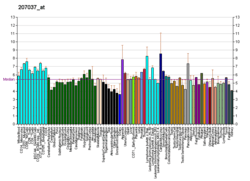RANK
Receptor activator of nuclear factor κ B (RANK), also known as TRANCE receptor or TNFRSF11A, is a member of the tumor necrosis factor receptor (TNFR) molecular sub-family. RANK is the receptor for RANK-Ligand (RANKL) and part of the RANK/RANKL/OPG signaling pathway that regulates osteoclast differentiation and activation. It is associated with bone remodeling and repair, immune cell function, lymph node development, thermal regulation, and mammary gland development. Osteoprotegerin (OPG) is a decoy receptor for RANKL, and regulates the stimulation of the RANK signaling pathway by competing for RANKL. The cytoplasmic domain of RANK binds TRAFs 1, 2, 3, 5, and 6 which transmit signals to downstream targets such as NF-κB and JNK.
RANK is constitutively expressed in skeletal muscle, thymus, liver, colon, small intestine, adrenal gland, osteoclast, mammary gland epithelial cells, prostate, vascular cell,[5] and pancreas. Most commonly, activation of NF-κB is mediated by RANKL, but over-expression of RANK alone is sufficient to activate the NF-κB pathway.[6]
RANKL (receptor activator for nuclear factor κ B ligand) is found on the surface of stromal cells, osteoblasts, and T cells.[7][8][9]
Structure
RANK is a 616 amino acid type I transmembrane protein. Its extracellular domain consists of 184 amino acids, its transmembrane domain has 21 amino acids, and its cytoplasmic domain consists of 383 amino acids.[10] Like other members of the TNFR family, it has four extracellular cysteine-rich pseudo-repeat domains (CRDs). It shares 40% amino acid identity with CD40. RANK is encoded on human chromosome 18q22.1. It shows 85% homology between mouse and human homologues.[6]
There are two monomers of RANK related by noncrystallographic 2-fold symmetry perpendicular to the long axis of the molecules in the asymmetric unit. RANK contains four CRDs spanning a length of 100 Angstroms which makes it the longest member of the TNFR family to date.[11]
The binding of RANKL to RANK trimerizes the receptor and activates a signaling pathway. The RANK-RANKL complex forms a heterohexameric complex. Only two of the four RANK CRDs are in direct contact with the RANKL. The majority of the complex’s residues are hydrophilic. Unlike other members of the TNFSF, each surface interaction in RANK-RANKL is continuous.[11]
Function
Osteoclastogenesis
TRAF6 has been shown to be imperative to the RANK-related osteoclastogenesis pathway.[12] RANKL binds to RANK, which then binds to TRAF6. TRAF6 stimulates the activation of the c-jun N-terminal kinase (JNK) and nuclear factor kappa-b (NF-kB) pathways which trigger differentiation and activation of osteoclasts. This system is balanced by the relative expression of OPG to RANKL, which are highly regulated by many factors including hormones, immune signals, and growth factors. An overexpression of RANKL can cause an overproduction and activation of osteoclasts, which break down bone. The balance between RANKL and OPG is a target for therapy in many diseases including estrogen deficiency-associated osteoporosis, rheumatoid arthritis, Paget’s disease, periodontal disease, and bone tumors and malignancies.[13]
Thermoregulation
RANK has also been shown to be a key in the thermoregulation signaling in females, which seems to be regulated by ovarian sex hormones. RANK is expressed in key regions of the brain associated with thermoregulation. Inactivation of RANK in these regions causes a loss of fever response to increased levels of RANKL. It has also been shown to be a critical mediator of fever response to lipopolysaccharide-induced fever and pro-inflammatory cytokines IL-1B and TNFa. This key role of the RANK-RANKL system may link the osteoporosis and hot flashes seen as symptoms of hormonal changes in post-menopausal women.[14]
Mammary gland development
RANK is constitutively expressed in mammary epithelial tissues. Calcium transferred from mother to fetus and neonate is provided by the degradation of the female bone by increased osteoclastic activity, which is regulated by the RANK/RANKL axis. RANKL also works through RANK to provide proliferative and survival signals to promote the final stages of lactating mammary gland development. Dysfunctional RANK or RANKL causes the arrest of differentiation and expansion of the alveolar bunds into mature lobulo-alveolar mammary structures, disabling the production of milk.[15]
Clinical significance
Cancer
RANK and RANKL have been reported to be expressed in some breast cancer and prostate cancer cell lines. RANKL expression in infiltrating T cells within mammary carcinomas activate RANK-expressing neoplastic mammary epithelial cells which stimulate metastasis. The expression of RANKL in these cells and the expression of RANK in bone cells may be the biological presentation of Paget’s seed and soil idea. The affinity for RANK of RANKL may be the reason these cancers tend to metastasize to bone. Once the tumor is seeded in the bone, the tumor cells stimulate bone resorption by secreting factors such as RANKL or prompting the surrounding stroma to express growth factors. These growth factors then upregulate production of RANKL which leads to osteoclastogenesis and bone destruction. The destruction of bone releases more growth factors and RANKL which induces more osteoclastogenesis, triggering a vicious cycle of bone destruction that is seen in metastatic bone tumors.[10]
Targeted therapies
Most therapies that target the RANK/RANKL/OPG axis aim to either down-regulate expression of RANKL or upregulate the expression of the decoy receptor OPG. For example, denosumab is a fully human monoclonal antibody that is directed against RANKL. In phase I and II trials, denosumab led to a decrease in bone resorption in multiple myeloma, prostate cancer and breast cancer patients.[10] Another study looked into developing small mimetics based on the structure of OPG that bind to RANK as well as RANKL and cause defective coupling between the two.[16]
Interactions
RANK has been shown to interact with:
- TRAF1,[17][18]
- TRAF2,[17][18][19][20]
- TRAF3,[17][18]
- TRAF5,[17][19][20] and
- TRAF6.[17][18][19][20][21]
See also
References
- GRCh38: Ensembl release 89: ENSG00000141655 - Ensembl, May 2017
- GRCm38: Ensembl release 89: ENSMUSG00000026321 - Ensembl, May 2017
- "Human PubMed Reference:". National Center for Biotechnology Information, U.S. National Library of Medicine.
- "Mouse PubMed Reference:". National Center for Biotechnology Information, U.S. National Library of Medicine.
- Sattler AM, Schoppet M, Schaefer JR, Hofbauer LC (2004). "Novel aspects on RANK ligand and osteoprotegerin in osteoporosis and vascular disease". Calcif. Tissue Int. 74 (1): 103–6. doi:10.1007/s00223-003-0011-y. PMID 14523602.
- Anderson DM, Maraskovsky E, Billingsley WL, Dougall WC, Tometsko ME, Roux ER, Teepe MC, DuBose RF, Cosman D, Galibert L (1997). "A homologue of the TNF receptor and its ligand enhance T-cell growth and dendritic-cell function". Nature. 390 (6656): 175–179. doi:10.1038/36593. PMID 9367155.
- Suda T, Takahashi N, Udagawa N, Jimi E, Gillespie MT, Martin TJ (1999). "Modulation of osteoclast differentiation and function by the new members of the tumor necrosis factor receptor and ligand families". Endocr. Rev. 20 (3): 345–57. doi:10.1210/er.20.3.345. PMID 10368775.
- Wong BR, Josien R, Choi Y (1999). "TRANCE is a TNF family member that regulates dendritic cell and osteoclast function". J. Leukoc. Biol. 65 (6): 715–24. PMID 10380891.
- Theill LE, Boyle WJ, Penninger JM (2002). "RANK-L and RANK: T cells, bone loss, and mammalian evolution". Annu. Rev. Immunol. 20: 795–823. doi:10.1146/annurev.immunol.20.100301.064753. PMID 11861618.
- Schramek, Daniel; Penninger, Josef M (2011). "The many roles of RANKL-RANK signaling in bone, breast and cancer". IBMS BoneKEy. 8 (5): 237–256. doi:10.1138/20110512.
- Liu C, Walter TS, Huang P, Zhang S, Zhu X, Wu Y, Wedderburn LR, Tang P, Owens RJ, Stuart DI, Ren J, Gao B (14 May 2010). "Structural and Functional Insights of RANKL-RANK Interaction and Signaling" (PDF). The Journal of Immunology. 184 (12): 6910–6919. doi:10.4049/jimmunol.0904033. PMID 20483727.
- Naito A, Azuma S, Tanaka S, Miyazaki T, Takaki S, Takatsu K, Nakao K, Nakamura K, Katsuki M, Yamamoto T, Inoue J (Jun 1999). "Severe osteopetrosis, defective interleukin-1 signalling and lymph node organogenesis in TRAF6-deficient mice". Genes to Cells. 4 (6): 353–62. doi:10.1046/j.1365-2443.1999.00265.x. PMID 10421844.
- Hofbauer, Lorenz C.; Heufelder, Armin E. (3 May 2001). "Role of receptor activator of nuclear factor-κB ligand and osteoprotegerin in bone cell biology". Journal of Molecular Medicine. 79 (5–6): 243–253. doi:10.1007/s001090100226.
- Hanada R, Leibbrandt A, Hanada T, Kitaoka S, Furuyashiki T, Fujihara H, Trichereau J, Paolino M, Qadri F, Plehm R, Klaere S, Komnenovic V, Mimata H, Yoshimatsu H, Takahashi N, von Haeseler A, Bader M, Kilic SS, Ueta Y, Pifl C, Narumiya S, Penninger JM (26 November 2009). "Central control of fever and female body temperature by RANKL/RANK". Nature. 462 (7272): 505–509. doi:10.1038/nature08596. PMID 19940926.
- Fata JE, Kong YY, Li J, Sasaki T, Irie-Sasaki J, Moorehead RA, Elliott R, Scully S, Voura EB, Lacey DL, Boyle WJ, Khokha R, Penninger JM (Sep 29, 2000). "The osteoclast differentiation factor osteoprotegerin-ligand is essential for mammary gland development". Cell. 103 (1): 41–50. doi:10.1016/s0092-8674(00)00103-3. PMID 11051546.
- Cheng X, Kinosaki M, Takami M, Choi Y, Zhang H, Murali R (15 December 2003). "Disabling of Receptor Activator of Nuclear Factor- B (RANK) Receptor Complex by Novel Osteoprotegerin-like Peptidomimetics Restores Bone Loss in Vivo". Journal of Biological Chemistry. 279 (9): 8269–8277. doi:10.1074/jbc.M309690200. PMID 14679212.
- Galibert L, Tometsko ME, Anderson DM, Cosman D, Dougall WC (Dec 1998). "The involvement of multiple tumor necrosis factor receptor (TNFR)-associated factors in the signaling mechanisms of receptor activator of NF-kappaB, a member of the TNFR superfamily". J. Biol. Chem. 273 (51): 34120–7. doi:10.1074/jbc.273.51.34120. PMID 9852070.
- Kim HH, Lee DE, Shin JN, Lee YS, Jeon YM, Chung CH, Ni J, Kwon BS, Lee ZH (Jan 1999). "Receptor activator of NF-kappaB recruits multiple TRAF family adaptors and activates c-Jun N-terminal kinase". FEBS Lett. 443 (3): 297–302. doi:10.1016/S0014-5793(98)01731-1. PMID 10025951.
- Darnay BG, Haridas V, Ni J, Moore PA, Aggarwal BB (Aug 1998). "Characterization of the intracellular domain of receptor activator of NF-kappaB (RANK). Interaction with tumor necrosis factor receptor-associated factors and activation of NF-kappab and c-Jun N-terminal kinase". J. Biol. Chem. 273 (32): 20551–5. doi:10.1074/jbc.273.32.20551. PMID 9685412.
- Darnay BG, Ni J, Moore PA, Aggarwal BB (Mar 1999). "Activation of NF-kappaB by RANK requires tumor necrosis factor receptor-associated factor (TRAF) 6 and NF-kappaB-inducing kinase. Identification of a novel TRAF6 interaction motif". J. Biol. Chem. 274 (12): 7724–31. doi:10.1074/jbc.274.12.7724. PMID 10075662.
- Mizukami J, Takaesu G, Akatsuka H, Sakurai H, Ninomiya-Tsuji J, Matsumoto K, Sakurai N (Feb 2002). "Receptor activator of NF-kappaB ligand (RANKL) activates TAK1 mitogen-activated protein kinase kinase kinase through a signaling complex containing RANK, TAB2, and TRAF6". Mol. Cell. Biol. 22 (4): 992–1000. doi:10.1128/mcb.22.4.992-1000.2002. PMC 134634. PMID 11809792.
Further reading
- Romas E, Gillespie MT, Martin TJ (2002). "Involvement of receptor activator of NFkappaB ligand and tumor necrosis factor-alpha in bone destruction in rheumatoid arthritis". Bone. 30 (2): 340–6. doi:10.1016/S8756-3282(01)00682-2. PMID 11856640.
- Collin-Osdoby P (2005). "Regulation of vascular calcification by osteoclast regulatory factors RANKL and osteoprotegerin". Circ. Res. 95 (11): 1046–57. doi:10.1161/01.RES.0000149165.99974.12. PMID 15564564.
- Clohisy DR, Mantyh PW (2005). "Bone cancer pain and the role of RANKL/OPG". Journal of musculoskeletal & neuronal interactions. 4 (3): 293–300. PMID 15615497.
- Anandarajah AP, Schwarz EM (2006). "Anti-RANKL therapy for inflammatory bone disorders: Mechanisms and potential clinical applications". J. Cell. Biochem. 97 (2): 226–32. doi:10.1002/jcb.20674. PMID 16240334.
- Baud'huin M, Duplomb L, Ruiz Velasco C, Fortun Y, Heymann D, Padrines M (2007). "Key roles of the OPG-RANK-RANKL system in bone oncology". Expert Rev Anticancer Ther. 7 (2): 221–32. doi:10.1586/14737140.7.2.221. PMID 17288531.
- Boyce BF, Xing L (2007). "Biology of RANK, RANKL, and osteoprotegerin". Arthritis Research & Therapy. 9 Suppl 1: S1. doi:10.1186/ar2165. PMC 1924516. PMID 17634140.
- Hughes AE, Shearman AM, Weber JL, Barr RJ, Wallace RG, Osterberg PH, Nevin NC, Mollan RA (1994). "Genetic linkage of familial expansile osteolysis to chromosome 18q". Hum. Mol. Genet. 3 (2): 359–61. doi:10.1093/hmg/3.2.359. PMID 7911698.
- Cody JD, Singer FR, Roodman GD, Otterund B, Lewis TB, Leppert M, Leach RJ (1997). "Genetic linkage of Paget disease of the bone to chromosome 18q". Am. J. Hum. Genet. 61 (5): 1117–22. doi:10.1086/301601. PMC 1716035. PMID 9345096.
- Anderson DM, Maraskovsky E, Billingsley WL, Dougall WC, Tometsko ME, Roux ER, Teepe MC, DuBose RF, Cosman D, Galibert L (1997). "A homologue of the TNF receptor and its ligand enhance T-cell growth and dendritic-cell function". Nature. 390 (6656): 175–9. doi:10.1038/36593. PMID 9367155.
- Haslam SI, Van Hul W, Morales-Piga A, Balemans W, San-Millan JL, Nakatsuka K, Willems P, Haites NE, Ralston SH (1998). "Paget's disease of bone: evidence for a susceptibility locus on chromosome 18q and for genetic heterogeneity". J. Bone Miner. Res. 13 (6): 911–7. doi:10.1359/jbmr.1998.13.6.911. PMID 9626621.
- Darnay BG, Haridas V, Ni J, Moore PA, Aggarwal BB (1998). "Characterization of the intracellular domain of receptor activator of NF-kappaB (RANK). Interaction with tumor necrosis factor receptor-associated factors and activation of NF-kappab and c-Jun N-terminal kinase". J. Biol. Chem. 273 (32): 20551–5. doi:10.1074/jbc.273.32.20551. PMID 9685412.
- Wong BR, Josien R, Lee SY, Vologodskaia M, Steinman RM, Choi Y (1998). "The TRAF family of signal transducers mediates NF-kappaB activation by the TRANCE receptor". J. Biol. Chem. 273 (43): 28355–9. doi:10.1074/jbc.273.43.28355. PMID 9774460.
- Galibert L, Tometsko ME, Anderson DM, Cosman D, Dougall WC (1999). "The involvement of multiple tumor necrosis factor receptor (TNFR)-associated factors in the signaling mechanisms of receptor activator of NF-kappaB, a member of the TNFR superfamily". J. Biol. Chem. 273 (51): 34120–7. doi:10.1074/jbc.273.51.34120. PMID 9852070.
- Nakagawa N, Kinosaki M, Yamaguchi K, Shima N, Yasuda H, Yano K, Morinaga T, Higashio K (1999). "RANK is the essential signaling receptor for osteoclast differentiation factor in osteoclastogenesis". Biochem. Biophys. Res. Commun. 253 (2): 395–400. doi:10.1006/bbrc.1998.9788. PMID 9878548.
- Kim HH, Lee DE, Shin JN, Lee YS, Jeon YM, Chung CH, Ni J, Kwon BS, Lee ZH (1999). "Receptor activator of NF-kappaB recruits multiple TRAF family adaptors and activates c-Jun N-terminal kinase". FEBS Lett. 443 (3): 297–302. doi:10.1016/S0014-5793(98)01731-1. PMID 10025951.
- Darnay BG, Ni J, Moore PA, Aggarwal BB (1999). "Activation of NF-kappaB by RANK requires tumor necrosis factor receptor-associated factor (TRAF) 6 and NF-kappaB-inducing kinase. Identification of a novel TRAF6 interaction motif". J. Biol. Chem. 274 (12): 7724–31. doi:10.1074/jbc.274.12.7724. PMID 10075662.
- Hsu H, Lacey DL, Dunstan CR, Solovyev I, Colombero A, Timms E, Tan HL, Elliott G, Kelley MJ, Sarosi I, Wang L, Xia XZ, Elliott R, Chiu L, Black T, Scully S, Capparelli C, Morony S, Shimamoto G, Bass MB, Boyle WJ (1999). "Tumor necrosis factor receptor family member RANK mediates osteoclast differentiation and activation induced by osteoprotegerin ligand". Proc. Natl. Acad. Sci. U.S.A. 96 (7): 3540–5. doi:10.1073/pnas.96.7.3540. PMC 22329. PMID 10097072.
- Dougall WC, Glaccum M, Charrier K, Rohrbach K, Brasel K, De Smedt T, Daro E, Smith J, Tometsko ME, Maliszewski CR, Armstrong A, Shen V, Bain S, Cosman D, Anderson D, Morrissey PJ, Peschon JJ, Schuh J (1999). "RANK is essential for osteoclast and lymph node development". Genes Dev. 13 (18): 2412–24. doi:10.1101/gad.13.18.2412. PMC 317030. PMID 10500098.
- Hughes AE, Ralston SH, Marken J, Bell C, MacPherson H, Wallace RG, van Hul W, Whyte MP, Nakatsuka K, Hovy L, Anderson DM (2000). "Mutations in TNFRSF11A, affecting the signal peptide of RANK, cause familial expansile osteolysis". Nat. Genet. 24 (1): 45–8. doi:10.1038/71667. PMID 10615125.
- Wong BR, Besser D, Kim N, Arron JR, Vologodskaia M, Hanafusa H, Choi Y (2000). "TRANCE, a TNF family member, activates Akt/PKB through a signaling complex involving TRAF6 and c-Src". Mol. Cell. 4 (6): 1041–9. doi:10.1016/S1097-2765(00)80232-4. PMID 10635328.
- Childs LM, Paschalis EP, Xing L, Dougall WC, Anderson D, Boskey AL, Puzas JE, Rosier RN, O'Keefe RJ, Boyce BF, Schwarz EM (1 February 2002). "In Vivo RANK Signaling Blockade Using the Receptor Activator of NF-κB:Fc Effectively Prevents and Ameliorates Wear Debris-Induced Osteolysis via Osteoclast Depletion Without Inhibiting Osteogenesis". Journal of Bone and Mineral Research. 17 (2): 192–199. doi:10.1359/jbmr.2002.17.2.192. PMID 11811549.
- Guerrini MM, Sobacchi C, Cassani B, Abinun M, Kilic SS, Pangrazio A, Moratto D, Mazzolari E, Clayton-Smith J, Orchard P, Coxon FP, Helfrich MH, Crockett JC, Mellis D, Vellodi A, Tezcan I, Notarangelo LD, Rogers MJ, Vezzoni P, Villa A, Frattini A (2008). "Human Osteoclast-Poor Osteopetrosis with Hypogammaglobulinemia due to TNFRSF11A (RANK) Mutations". The American Journal of Human Genetics. 83 (1): 64–76. doi:10.1016/j.ajhg.2008.06.015. PMC 2443850. PMID 18606301.
External links
- RANK+Protein at the US National Library of Medicine Medical Subject Headings (MeSH)
This article incorporates text from the United States National Library of Medicine, which is in the public domain.





